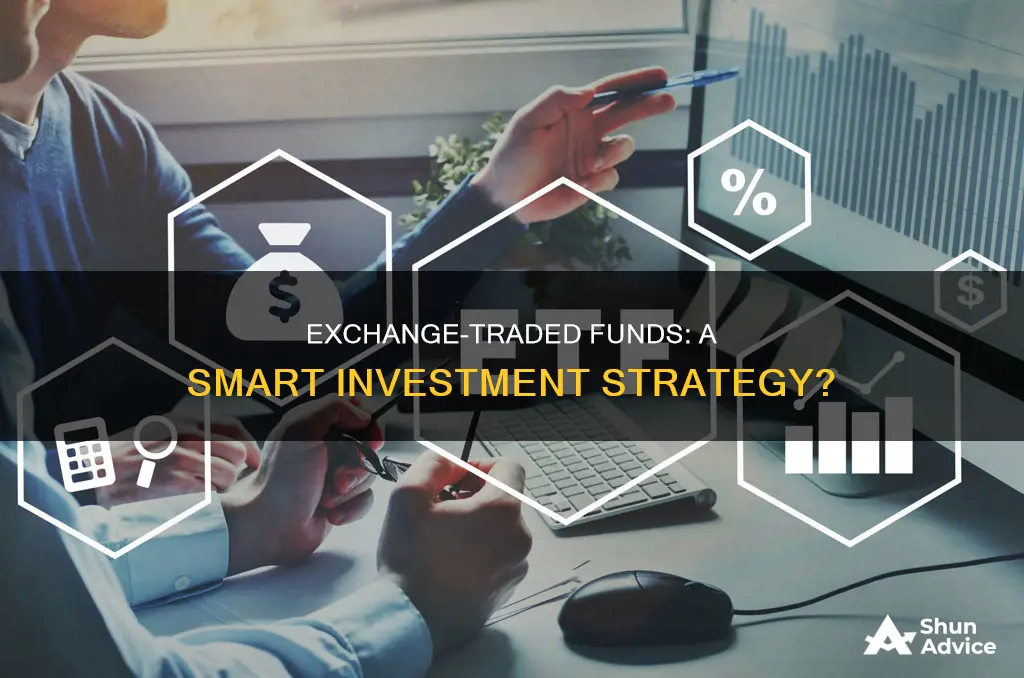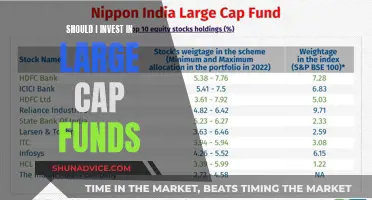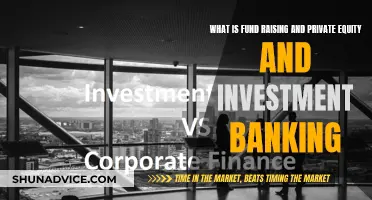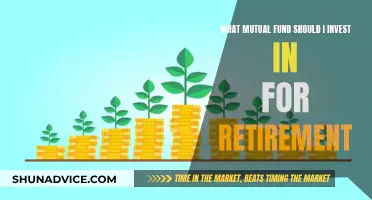
Exchange-traded funds (ETFs) are a popular investment vehicle that pools a group of securities into a fund, which can then be traded like an individual stock on an exchange. ETFs are an excellent entry point for beginners to start investing as they are fairly simple to understand and can generate impressive returns without much expense or effort.
ETFs offer a range of benefits, including diversification, low costs, and the ability to trade shares live during the trading day. They also provide exposure to a variety of stocks, bonds, and other assets, typically at a minimal expense. Additionally, ETFs are more liquid and easier to buy and sell than mutual funds.
However, there are also some potential drawbacks to consider. ETFs may have higher costs compared to investing in a specific stock, and they can suffer from lower dividend yields and potential liquidity issues.
Overall, ETFs can be a great investment option, particularly for those seeking a diversified and relatively low-risk approach to investing.
What You'll Learn

ETFs vs. mutual funds
Exchange-traded funds (ETFs) and mutual funds are both managed "baskets" or "pools" of securities, such as stocks or bonds. They are less risky than investing in individual stocks and bonds and are overseen by professional portfolio managers. However, there are some key differences between the two investment types.
ETFs trade like stocks on major exchanges such as the NYSE and Nasdaq. Share prices fluctuate throughout the trading day, and you can buy and sell ETF shares whenever the stock market is open. You choose how many shares you want to purchase.
With mutual funds, you typically invest a set dollar amount, and transactions occur once per day after the market closes. You buy and sell shares directly with the fund provider, and the fund's manager calculates the value of a share after the market closes.
Investment Minimums
Mutual funds typically have minimum investment requirements of hundreds or thousands of dollars. ETFs, on the other hand, can be purchased for the price of a single share, which could be as little as $50.
Management Style
Most ETFs are passively managed. They track market indexes or sector indexes. Mutual funds are usually actively managed, meaning fund managers make decisions about how to allocate assets to beat the market. Actively managed funds tend to have higher fees and expense ratios.
Tax Efficiency
ETFs are often considered more tax-efficient than mutual funds. Mutual funds may trigger capital gains for shareholders when a sale of securities within the fund occurs, even if an investor has an unrealized loss on the overall mutual fund investment. ETFs, on the other hand, may generate fewer capital gains for investors due to lower turnover.
Suitability
If you want to be able to trade throughout the day, have more hands-on control over the price of your trade, seek lower investment minimums, or are looking for an index fund, then an ETF could be more suitable for you.
If you want to repeat specific transactions automatically, a mutual fund could be the better option. You can set up automatic investments and withdrawals with mutual funds.
Other Considerations
ETFs are often cheaper to invest in than mutual funds, and they are more liquid (easy to buy and sell). However, ETFs don't have quite as much return potential as buying individual stocks, and they are not free to invest in.
Mutual funds may be preferable if you are investing in a less efficient market, as there may be greater opportunities through active portfolio management.
Ultimately, the decision to invest in ETFs, mutual funds, or a combination of both will depend on your financial goals and investment style.
Bond Index Funds: Choosing the Right Investment for You
You may want to see also

ETFs vs. stocks
Exchange-traded funds (ETFs) and stocks are similar in some ways, but they are fundamentally different and present various upsides and risks.
Stocks
Stocks represent a fractional ownership interest in a business and typically trade on an exchange. When you own a stock, you’re investing in the success of that company and only that company. Individual stocks can perform phenomenally over time, but they may be volatile in the short term, fluctuating massively. It takes a lot of work to follow a stock, understand the industry, analyse financial statements and keep up with earnings.
ETFs
ETFs are collections of assets, often stocks, bonds or a mix of the two. A single ETF might own dozens, sometimes hundreds, of stocks. So by owning a single share of the ETF, investors can own an indirect stake in all the stocks (or other assets) held by the fund. It’s a great (and often inexpensive) way to buy a collection of stocks. ETFs often invest in stocks that have a specific focus area, for example, large companies, value-priced stocks, dividend-paying companies or those operating in a specific industry, such as financial companies.
| | ETFs | Stocks |
|---|---|---|
| Risk | ETFs provide the benefits of diversification, including lower risk and less volatility, which often makes a fund safer to own than an individual stock. | The risk is concentrated in a stock’s performance. |
| Returns | An ETF’s return is the weighted average of all its holdings. So if it owns many strong stocks, the ETF will rise. If it owns many poorly performing stocks, then the ETF will decline, too. | A single stock can potentially return a lot more than an ETF, where you receive the weighted average performance of the holdings. |
| Taxes | ETFs are the most tax-efficient. | Stocks are taxed at either ordinary income tax rates or capital gains rates. |
| Diversification | ETFs allow you to buy one fund and have a stake in dozens or even thousands of companies. | You will need to invest in multiple stocks to achieve the same level of diversification as an ETF. |
| Trading | ETFs can be traded at no cost at most major online brokers. | |
| Effort | It takes little investing expertise to invest in ETFs and earn high returns. | Much effort is required to analyse and value individual stocks, and many people simply don’t have the time or desire to do so. |
| Dividends | Like stocks, ETFs can pay dividends. | Stocks can pay dividends, and over time those dividends can rise, as the top companies increase their payouts. |
| Costs | ETFs do charge an incremental cost, the expense ratio, for owning the fund. | |
Merrill Mutual Funds: Choosing the Right Investment for You
You may want to see also

Pros and cons of ETFs
Exchange-traded funds (ETFs) are a type of investment fund that offers the diversification benefits of mutual funds while mimicking the ease of stock trading. They are considered low-risk investments because they are low-cost and hold a basket of stocks or other securities, increasing diversification. Here are some of the pros and cons of investing in ETFs:
Pros of ETFs:
- Lower fees: ETFs often have lower fees than other types of funds, such as mutual funds, due to their passive management structure.
- Tax efficiency: ETFs are more tax-efficient than mutual funds because they generate fewer capital gains and have lower expense ratios.
- Diversification: ETFs provide instant diversification by investing in many assets at once, reducing an investor's risk.
- Flexibility: ETFs can be traded during regular market hours, offering more flexibility than mutual funds, which can only be traded once a day after the market closes.
- Risk management: ETFs offer risk management opportunities such as market, stop-loss, and limit orders.
- Accessibility: ETFs are accessible to a wide range of investors, from individuals to institutions, and can be purchased on most online investing platforms and apps, often with commission-free trading.
Cons of ETFs:
- Costs: While ETFs are generally more affordable than mutual funds, investors still incur trading fees when buying and selling, and management fees in the form of expense ratios.
- Limited diversification: In some cases, ETFs might limit investors to large-cap stocks within certain sectors or foreign markets, reducing exposure to mid- and small-cap companies and potential growth opportunities.
- Lower returns: ETFs might offer lower returns than investing directly in high-yielding stocks, particularly for investors willing to take on more risk.
- Challenging for hands-on investors: ETFs may not be ideal for investors who want more control over their investments or wish to avoid certain asset classes or industries for personal or ethical reasons.
- Intraday pricing: Intraday pricing fluctuations could induce longer-term investors to trade unnecessarily or make emotional decisions.
Index Funds: Right Time to Invest?
You may want to see also

How to invest in ETFs
- Open a brokerage account: You will need a brokerage account to buy and sell securities like ETFs. You can do this online, and many brokers have no account minimums, transaction fees, or inactivity fees.
- Find and compare ETFs: There are thousands of ETFs listed, so screening tools are critical for finding the right ones. Criteria to consider include administrative expenses (expense ratios), commissions, volume, holdings, performance, and trading prices.
- Buy your chosen ETFs: The process for buying ETFs is similar to buying stocks. You will need the ticker symbol, the current trading price, and the number of shares you wish to buy. You can also specify the type of order: market, limit, stop, or stop-limit.
- Sit back and relax: Congratulations, you've bought your first ETF! These funds can form the basis of a well-diversified portfolio. There is no need to compulsively check their performance, but you can access this information via your brokerage's website or by typing the ticker symbol into a search engine.
Additional Information
- Robo-advisors: Robo-advisors build and manage an investment portfolio for you, often using ETFs. They are a good option if you would rather have someone else make investment decisions for you.
- Expense ratios: ETFs charge fees, known as expense ratios, which are listed as an annual percentage. For example, a 1% expense ratio means you will pay $10 in fees for every $1000 you invest.
- Dividends: Most ETFs pay dividends, which can be paid to you as cash or automatically reinvested through a dividend reinvestment plan (DRIP).
- Taxes: If you buy ETFs in a standard brokerage account (not an IRA), they could result in taxable income. Any gains you make from selling an ETF will be taxed according to capital gains tax rules, and any dividends you receive will likely be taxable as well.
- Minimum investment: ETFs don't have minimum investment requirements, but they trade on a per-share basis, so you will need at least the current price of one share to get started.
- Passive vs. Active ETFs: Passive ETFs (index funds) track a stock index, like the S&P 500. Active ETFs hire portfolio managers to invest their money, with the goal of beating an index's performance.
- Brokerage platforms: When choosing a brokerage platform, consider factors such as the fees and commissions charged, the range of ETFs offered, and the ease of access to your money.
- Liquidity: ETFs are highly liquid assets that can be easily bought and sold at the investor's discretion.
- Suitability for beginners: ETFs are a perfect way for beginners to get started investing. They are simple to understand, relatively inexpensive, and can generate impressive returns without much effort.
Mutual Funds: Risky or Safe Investment Choice?
You may want to see also

Types of ETFs
There are several types of ETFs available to investors, each with its own benefits, risks, and costs. Here are some of the most common types of ETFs:
Equity ETFs
Equity ETFs invest in stocks and are typically designed for long-term growth. They are usually less risky than individual stocks but may carry more risk than bond ETFs. Examples of equity ETFs include international ETFs, which invest in companies headquartered outside the investor's home country, and dividend ETFs, which focus on companies with a history of paying dividends.
Bond/Fixed-Income ETFs
Bond ETFs invest in a portfolio of bonds or a single bond issued by governments, municipalities, or private companies. They are a good way to generate regular cash payments for investors and are considered lower-risk investments.
Commodity ETFs
Commodity ETFs invest in raw materials such as agricultural goods, energy, and precious metals. These ETFs can be riskier and are not suitable for all investors. They can be structured in different ways, such as owning the physical commodity or investing in companies that produce, transport, or store these goods.
Exchange-Traded Notes (ETNs)
ETNs are technically not ETFs, but they share similar characteristics. They track a basket of assets, often commodities, bonds, derivatives, or exotic assets. ETNs do not own the underlying assets but are backed by the creditworthiness of the issuer.
International ETFs
International ETFs invest in foreign stocks, providing exposure to specific countries or country blocs. They are a less risky way to gain international investment exposure.
Bitcoin or Crypto ETFs
These ETFs provide exposure to cryptocurrencies like Bitcoin and Ethereum. The SEC has recently approved spot Bitcoin ETFs, which directly track the price of Bitcoin and can be traded in brokerage accounts.
Sector ETFs
Sector ETFs invest in specific sectors or industries, such as healthcare, financials, or industrials. They can be useful for investors tracking business cycles, as certain sectors perform better during expansion or contraction periods. Examples include gold ETFs and marijuana ETFs.
Leveraged ETFs
Leveraged ETFs aim to amplify the returns of an underlying index. For example, a 2x leveraged S&P 500 ETF would aim to return 2% if the S&P 500 rises by 1%. However, it's important to note that they also amplify losses.
A Guide to Investing in SBI Mutual Funds
You may want to see also
Frequently asked questions
ETFs are a great way to get started with investing as they are easy to understand and can generate impressive returns without much expense or effort. They are also a good way to gain exposure to companies that you may not otherwise be able to invest in. ETFs are more liquid and have lower expense ratios than mutual funds.
ETFs are considered low-risk investments but they are not risk-free. ETFs that track a specific sector or industry may be limited to large-cap stocks, which could mean missing out on the growth potential of small- and mid-cap companies. ETFs are also subject to market risk, so if the market moves in an unfavourable direction, the value of your ETF will also drop.
To invest in ETFs, you will need to open a brokerage account with a provider that offers the ETFs you want to invest in. You can then use the provider's ETF screener to search for ETFs that match your investment goals and risk tolerance. Once you have chosen the ETFs you want to invest in, you can place a buy order through your brokerage account.







